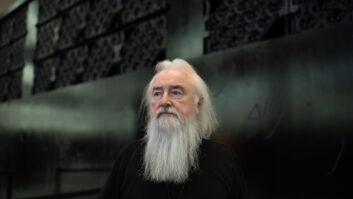
New York, NY (September 27, 2019)—New York City is in Vampire Weekend’s blood. The group was founded uptown at Columbia University in 2006, and 13 years later, the band launched its fifth album, Father of the Bride, with a short promo tour that included a marathon stop downtown at Webster Hall, playing nearly every song in the band’s catalog across three 90-minute sets in one day in May. In September, now barnstorming through the second North American leg of its world tour, the band upped the ante for—you guessed it—the New York City stop by not only headlining Madison Square Garden for the first time, but also playing the vaunted venue in-the-round to accommodate more fans.
For the sold-out show, the stage was set at one end of the arena without a backdrop, allowing the seats behind it to be sold. The bigger crowd meant the tour’s audio provider, Solotech, had to field a larger L-Acoustics line array system—Paul Owen, general manager of the company’s Nashville office, met the challenge easily. Owen has handled Vampire Weekend tours (as well as numerous other A-list artists) for 10 years, and through it all, he’s gained an understanding of the band’s aural needs. “The mixes are all dialed in,” he noted, so the biggest challenge that day would simply be re-tuning the room for 360 coverage from 180. “It should be pretty straightforward.”
Mixing the four-member band and three additional touring musicians, Vampire Weekend’s longtime FOH engineer Neil Heal has been looking after 120 inputs on a DiGiCo SD5 desk, all running at 96k. “I decided not to use Waves on this, so I have no plug-ins!” he reported. “I figure if I want something specific, I’ll get the real thing in a rack, so if I need to change any parameters, it’s right at hand and I can just look over and always see what it’s doing. I do have a couple of Empirical Labs EL8X Distressors and a couple of effects units that have specific capabilities that the console can’t do.”
The set list changes nightly, so while Heal uses snapshots to recall fader positions and effects at the start of a song, it’s all mixed on the fly across the typically 32-song, two-and-a-half-hour shows. “All the songs sound so much bigger and better performed as a seven-piece,” Heal said. “It really is a great show to mix since there’s an element of ‘the weird’ involved. The albums sound crazy at times—as they do when played live.”
With that in mind, Heal mixes the songs pretty closely to the album versions. “That said, there definitely is a live feel—the song arrangements can differ and they are ‘jamming out’ a lot and segueing songs into one another…. It’s just [a matter of] knowing the music very well, and accepting that weird happens sometimes on purpose, [and when it does, to] embrace that.”
Critical to the band’s sound is lead vocalist/band leader Ezra Koenig, whose singing sounds like literally no one else. His mic of choice: a Sennheiser e945. “I love the e945s on vocals,” commented Heal. “I think they sound great. I have a pretty quiet singer and I can get so much gain before feedback without it behaving like an additional overhead.”
Monitor engineer Matt Andrade joined the tour in May, taking over that position from Chris Moon, who had been with Vampire Weekend since 2006 and is still peripherally involved with the current tour.
“I took over Chris’ Avid S6L show file,” Andrade explained. “Since the band was already well into the beginning of a new album tour cycle, the goal was to make the transition between Chris and me as seamless as possible, so I’m currently mixing on an Avid S6L, integrated with Waves SoundGrid. Some of my favorite Waves plug-ins include the F6 Dynamic EQ, C6 Multiband Compressor, NLS Buss and Channel, PSE Primary Source Expander and the SSL E-Channel. I also like to use the Empirical Labs Arouser plug-in.”
All seven band members use Shure PSM 1000 systems with JH Audio in-ear monitors; while two opt for Roxannes, the other five, including Koenig, and all the backline and audio techs use JH16v2s. As a result, the pair of L-Acoustics X15 floor wedges for the lead vocal and guitar at downstage center stay muted unless needed in an emergency.
They aren’t the only L-Acoustics boxes on the tour, however, as a massive K2 system hangs above the stage. For typical shows, the P.A. includes main left and right arrays of 18 K2 per side, along with 12 Karas a side for side hangs. Subs include 12 KS28s on the floor, with a half-dozen Karas and four Arcs IIs used for front fill and out fill. The subs typically go in evenly spaced pairs across the floor in front of the stage with a slight delay arc on them to spread their coverage out toward the sides. Since seating was in-the-round at the New York show, the system had to be appropriately bulked up, and 112 cabinets were hung for the occasion.
Mixing the big homecoming gig in a sold-out legendary venue was a treat for Heal, who has mixed the band for the last 11 years. “It’s been a great journey seeing Vampire Weekend go from small clubs to now selling out Madison Square Garden with 360 degrees and headlining festivals around the world,” he mused. There was little time to revel in the moment, however; audio would be struck right after the show and the buses would head out for Montreal, the next date on the itinerary. Surveying the scene, he allowed, “It’s been a hectic day.”
Solotech • www.solotech.com
L-Acoustics • www.l-acoustics.com





